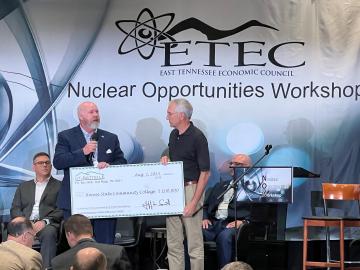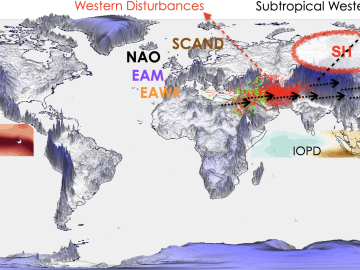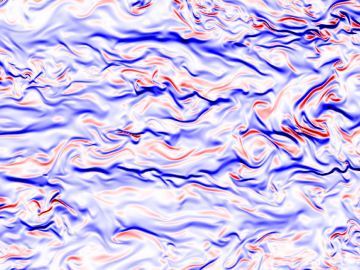
Filter News
Area of Research
- Advanced Manufacturing (1)
- Biology and Environment (19)
- Computer Science (1)
- Energy Science (22)
- Fusion and Fission (14)
- Fusion Energy (4)
- Isotopes (12)
- Materials (46)
- Materials Characterization (1)
- Materials for Computing (3)
- Materials Under Extremes (1)
- National Security (7)
- Neutron Science (14)
- Nuclear Science and Technology (21)
- Nuclear Systems Modeling, Simulation and Validation (1)
- Supercomputing (18)
News Topics
- (-) Isotopes (19)
- (-) Materials Science (53)
- (-) Nuclear Energy (52)
- 3-D Printing/Advanced Manufacturing (48)
- Advanced Reactors (17)
- Artificial Intelligence (34)
- Big Data (21)
- Bioenergy (35)
- Biology (34)
- Biomedical (29)
- Biotechnology (8)
- Buildings (15)
- Chemical Sciences (29)
- Clean Water (7)
- Composites (7)
- Computer Science (62)
- Coronavirus (29)
- Critical Materials (8)
- Cybersecurity (13)
- Education (3)
- Emergency (1)
- Energy Storage (42)
- Environment (72)
- Exascale Computing (18)
- Fossil Energy (2)
- Frontier (20)
- Fusion (22)
- Grid (23)
- High-Performance Computing (36)
- Hydropower (3)
- Irradiation (2)
- Machine Learning (23)
- Materials (61)
- Mathematics (4)
- Mercury (3)
- Microelectronics (2)
- Microscopy (15)
- Molten Salt (3)
- Nanotechnology (24)
- National Security (23)
- Neutron Science (67)
- Partnerships (24)
- Physics (27)
- Polymers (11)
- Quantum Computing (12)
- Quantum Science (23)
- Security (6)
- Simulation (29)
- Software (1)
- Space Exploration (6)
- Summit (26)
- Transportation (33)
Media Contacts

Leigh R. Martin, a senior scientist and leader of the Fuel Cycle Chemical Technology group at ORNL, has been named a Fellow of the American Chemical Society for 2023.

Eric Myers of ORNL has been named a senior member of the Institute of Electrical and Electronics Engineers, effective June 21.

Roane State Community College today announced the launch of a Nuclear Technology Program with a $100,000 contribution from UT-Battelle, LLC, which manages and operates ORNL for the Department of Energy.

Wildfires have shaped the environment for millennia, but they are increasing in frequency, range and intensity in response to a hotter climate. The phenomenon is being incorporated into high-resolution simulations of the Earth’s climate by scientists at the Department of Energy’s Oak Ridge National Laboratory, with a mission to better understand and predict environmental change.

As extreme weather devastates communities worldwide, scientists are using modeling and simulation to understand how climate change impacts the frequency and intensity of these events. Although long-term climate projections and models are important, they are less helpful for short-term prediction of extreme weather that may rapidly displace thousands of people or require emergency aid.

JungHyun Bae is a nuclear scientist studying applications of particles that have some beneficial properties: They are everywhere, they are unlimited, they are safe.

Simulations performed on the Summit supercomputer at ORNL revealed new insights into the role of turbulence in mixing fluids and could open new possibilities for projecting climate change and studying fluid dynamics.

Like most scientists, Chengping Chai is not content with the surface of things: He wants to probe beyond to learn what’s really going on. But in his case, he is literally building a map of the world beneath, using seismic and acoustic data that reveal when and where the earth moves.

An innovative and sustainable chemistry developed at ORNL for capturing carbon dioxide has been licensed to Holocene, a Knoxville-based startup focused on designing and building plants that remove carbon dioxide

ORNL will team up with six of eight companies that are advancing designs and research and development for fusion power plants with the mission to achieve a pilot-scale demonstration of fusion within a decade.


